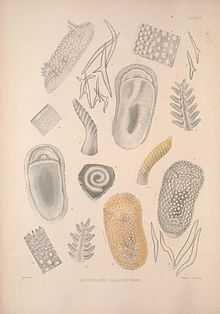Adalaria proxima
| Adalaria proxima | |
|---|---|
 | |
| Adalaria proxima in the original combination Doris proxima in Alder & Hancock, 1854 | |
| Scientific classification | |
| Kingdom: | Animalia |
| Phylum: | Mollusca |
| Class: | Gastropoda |
| (unranked): | clade Heterobranchia clade Euthyneura |
| Superfamily: | Onchidoridoidea |
| Family: | Onchidorididae |
| Genus: | Adalaria |
| Species: | Adalaria proxima |
| Binomial name | |
| Adalaria proxima (Alder & Hancock, 1854)[1] | |
| Synonyms | |
|
Doris proxima | |
Adalaria proxima is a species of sea slug, a dorid nudibranch, a shell-less marine gastropod molluscs in the family Onchidorididae. This species is found in the northeastern and northwestern parts of the Atlantic Ocean. It is also known from the northeastern Pacific Ocean.
Description
Adalaria proxima is oval in shape and grows to a length of about 25 mm (1 in). The head has a flattened piece of tissue above the mouth. The mantle is covered with club-shaped tubercles with pointed ends which are stiffened with calcareous spicules (spine-like structures). The body is a yellowish-orange colour, but is often quite a pale shade, especially in the northernmost part of the animal's range. The blunt-ended rhinophores (sensory tentacles on the head) are often darker in colour than the rest of the animal, and each bears up to nineteen thin plates. The anal papilla is surrounded by a ring of about twelve feathery gills.[2] This species can be confused with Onchidoris muricata, but that species is usually smaller and paler and has rhinophores that have tips which are more pointed.[3]
Distribution
Adalaria proxima is native to the colder parts of the north Atlantic Ocean. Its range extends from the North Sea, the Baltic Sea and the White Sea to eastern Greenland, and the eastern coast of North America as far south as Massachusetts. Its depth range reaches as deep as 60 metres (200 ft).[2] It is also known from the northern Pacific Ocean, from British Columbia to South Korea.[4]
Biology
Adalaria proxima feeds on the colonial bryozoan Electra pilosa, which is often found encrusted on the fronds of large brown algae such as Laminaria and Fucus serratus.[2] It also feeds on other genera of bryozoa such as Membranipora, Alcyonidium and Flustrellidra.[3]
Breeding takes place in late winter and spring, when the eggs are laid in coils. The eggs are fairly large, and hatch after about forty days. The larvae have a yolksac and do not feed but drift as part of the plankton before settling in suitable habitat.[4]
References
- ↑ Gofas, Serge (2014). "Adalaria proxima (Alder & Hancock, 1854)". World Register of Marine Species. Retrieved 2014-12-28.
- ↑ 2.0 2.1 2.2 de Kluijver, M.J.; Ingalsuo, S.S.; de Bruyne, R.H. "Adalaria proxima". Mollusca of the North Sea. Marine Species Identification Portal. Retrieved 2014-12-28.
- ↑ 3.0 3.1 Neal, Ken (2007). "Adalaria proxima". Marine Life Information Network. Retrieved 2014-12-28.
- ↑ 4.0 4.1 Rudman, Bill (2001-07-05). "Adalaria proxima (Alder & Hancock, 1854)". The sea slug forum. Retrieved 2014-12-28.